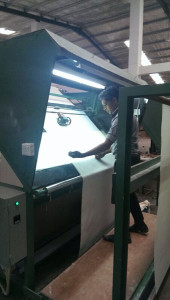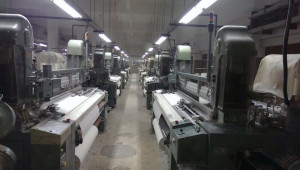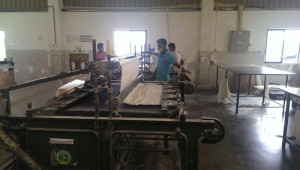Step 01 :- Warping Process
 This is where the yarn is parallely winded from cone on to a warp beam. Some of the objectives of this is to increase the weavability of the yarn and to increase the quality of the yarn. This step is important because of many reasons, some of which include the construction of parallel yarn sheets, yarn faults such as thick and thin places and larger knots being modified and most importantly warping accelerates the next process which is sizing.
This is where the yarn is parallely winded from cone on to a warp beam. Some of the objectives of this is to increase the weavability of the yarn and to increase the quality of the yarn. This step is important because of many reasons, some of which include the construction of parallel yarn sheets, yarn faults such as thick and thin places and larger knots being modified and most importantly warping accelerates the next process which is sizing.
Step 02 :- Sizing Process
This is done during beam preparation, and is the applying of an adhesive coating on the yarn surface by using different types of size materials. Steam is essential for this. It is to protect the yarn. Some of the main purposes of sizing are to improve the weavability of warp yarn, to maintain good fabric quality, to increase the elasticity of the yarn and to reduce electrostatic formation. Sizing gives yarns higher elasticity, higher yarn strength, lower flexibility and increased smoothness aside from many other properties.
Step 03 :- Weaving Process
This is the step of the yarns being laced together to form the fabric. This is a five part process which includes shedding, picking, beating up, left off and take up. They must be coordinated to take place correctly and not obstruct each other. It is called the weaving cycle. The weaving process is an important step in the textile manufacturing process because this is what holds the fabric together.
Step 04 :- Greige checking or Greige inspection
 This is checking the fabric for faults and defects such as broken ends and stains. Some of the other points that are inspected at this stage are EPI, PPI, width and length of fabric and GSM. These inspections are usually carried out visually or by pick glass, measurements by tape, UV lamps, streak analysis and spotting with staining agents.
This is checking the fabric for faults and defects such as broken ends and stains. Some of the other points that are inspected at this stage are EPI, PPI, width and length of fabric and GSM. These inspections are usually carried out visually or by pick glass, measurements by tape, UV lamps, streak analysis and spotting with staining agents.
Step 05 :- Greige Folding
This is where the woven fabric is folded through machines and sent to the final Step 6 which is Greige Loading. This is the process of loading the folded fabric into the vehicles to be transported for processing, dying, printing and packing.



